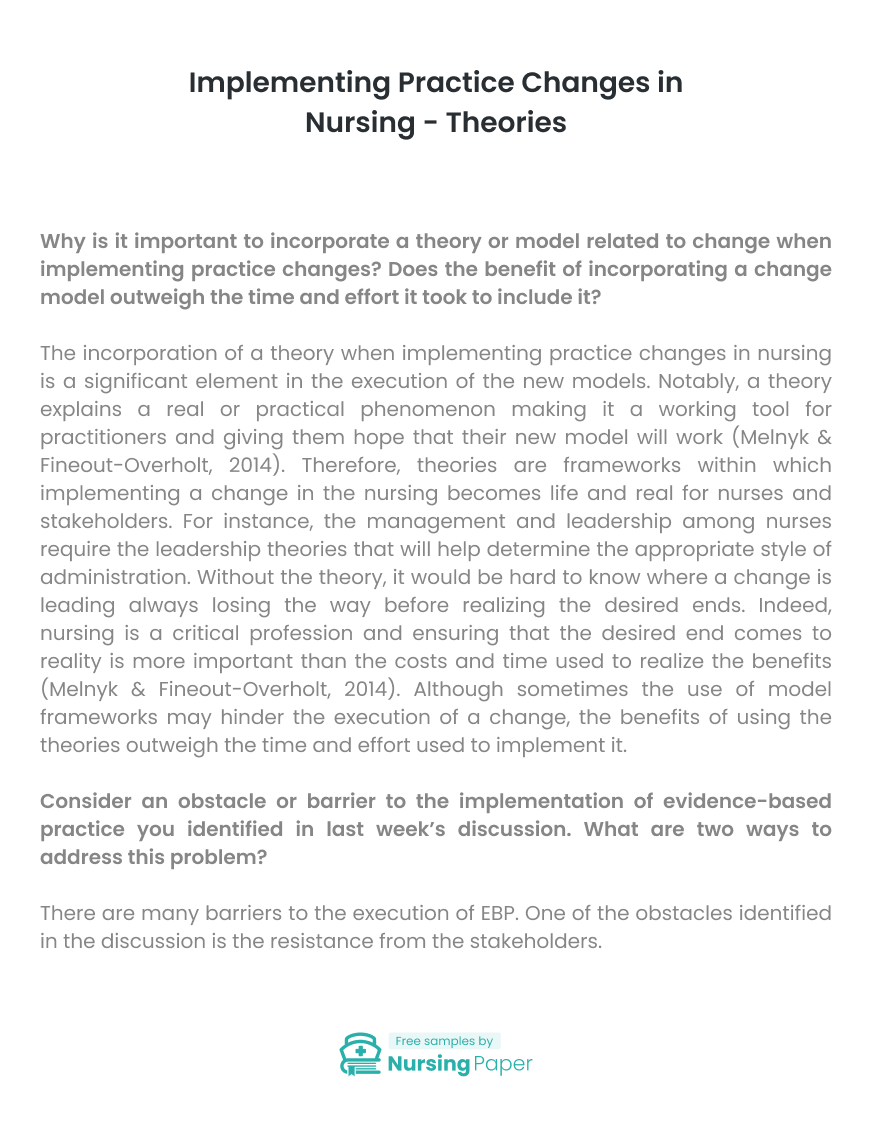
Implementing Practice Changes in Nursing – Theories
Question 1
Why is it important to incorporate a theory or model related to change when implementing practice changes? Does the benefit of incorporating a change model outweigh the time and effort it took to include it?
The incorporation of a theory when implementing practice changes in nursing is a significant element in the execution of the new models. Notably, a theory explains a real or practical phenomenon making it a working tool for practitioners and giving them hope that their new model will work (Melnyk & Fineout-Overholt, 2014). Therefore, theories are frameworks within which implementing a change in the nursing becomes life and real for nurses and stakeholders. For instance, the management and leadership among nurses require the leadership theories that will help determine the appropriate style of administration. Without the theory, it would be hard to know where a change is leading always losing the way before realizing the desired ends. Indeed, nursing is a critical profession and ensuring that the desired end comes to reality is more important than the costs and time used to realize the benefits (Melnyk & Fineout-Overholt, 2014). Although sometimes the use of model frameworks may hinder the execution of a change, the benefits of using the theories outweigh the time and effort used to implement it.


Question 2
Consider an obstacle or barrier to the implementation of evidence-based practice you identified in last week’s discussion. What are two ways to address this problem?
There are many barriers to the execution of EBP. One of the obstacles identified in the discussion is the resistance from the stakeholders. Indeed, nurses, patients, caregivers, and nurse leaders are the primary stakeholders in the implementation of the EBP. Therefore, it will be difficult to implement the practice without involving all the stakeholders in the formulation level (Melnyk & Fineout-Overholt, 2014). It is significant to ensure that the different parties involved have their say in the planned EBP before its execution. Moreover, educating the parties is essential in ensuring that they have adequate knowledge on the effectiveness and implementation of the program (Melnyk & Fineout-Overholt, 2014). For example, some of the stakeholders may have little knowledge or understanding of the program, but after the education, they may find how much relevant it is to them and reduce their intentions to oppose it.
1. Melnyk, B. M., & Fineout-Overholt, E. (2014). Evidence-based practice in nursing and healthcare: A guide to best practice (3rd ed.). Philadelphia, PA: Lippincott Williams & Wilkins.



The download will start shortly.

The download will start shortly.
 Subject:
Health and Social Care
Subject:
Health and Social Care  Number of pages: 2
Number of pages: 2  Subject:
Health and Social Care
Subject:
Health and Social Care  Number of pages: 20
Number of pages: 20  Subject:
Health and Social Care
Subject:
Health and Social Care  Number of pages: 10
Number of pages: 10  Subject:
Nursing
Subject:
Nursing  Number of pages: 2
Number of pages: 2  Subject:
Nursing
Subject:
Nursing  Number of pages: 6
Number of pages: 6  Subject:
Nursing
Subject:
Nursing  Number of pages: 2
Number of pages: 2  Subject:
Nursing
Subject:
Nursing  Number of pages: 2
Number of pages: 2  Subject:
Health and Social Care
Subject:
Health and Social Care  Number of pages: 3
Number of pages: 3  Subject:
Health and Social Care
Subject:
Health and Social Care  Number of pages: 3
Number of pages: 3  Subject:
Nursing
Subject:
Nursing  Number of pages: 10
Number of pages: 10  Subject:
Health and Social Care
Subject:
Health and Social Care  Number of pages: 6
Number of pages: 6  Subject:
Medicine
Subject:
Medicine  Number of pages: 2
Number of pages: 2  Subject:
Nursing
Subject:
Nursing  Number of pages: 4
Number of pages: 4  Subject:
Nursing
Subject:
Nursing  Number of pages: 6
Number of pages: 6  Subject:
Nursing
Subject:
Nursing  Number of pages: 8
Number of pages: 8 
